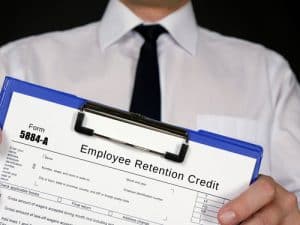Wondering how to qualify for the employee retention credit? If you fought to keep your employees on your payroll during 2020 and 2021, there’s a good chance that you meet the ERC qualifications..
Our content reflects the editorial opinions of our experts. While our site makes money through
referral partnerships, we only partner with companies that meet our standards for quality, as outlined in our independent
rating and scoring system.

On 1/10/24, IRS Commissioner Daniel Werfel announced that the IRS is continuing to improve and automate ERC review procedures and will begin processing new ERC claims in the spring following the moratorium implemented in September. Existing claims are still being processed and eligible businesses can still submit an ERC claim through reputable ERC companies to be processed when the moratorium ends. Visit our full breakdown of the ERC pause for the latest information.
If you kept your employees on your payroll in 2020 and 2021, there’s a good chance your business qualifies for the Employee Retention Credit. This refundable tax credit could potentially put thousands of dollars back into your business.
In this post, we’re going to break down how to qualify for ERC. We’ll discuss ERC qualification and eligibility guidelines and the next steps you can take to claim your ERC refund if you’re eligible.
If you don’t have the time to wade through IRS guidelines, you can let an expert do the work for you. Start by checking out the best ERC companies, most of which offer a free ERC analysis to help you determine if your business qualifies for a refund.
What Is The ERC Credit? The Quick Answer
The Employee Retention Credit (ERC) program was created under the Coronavirus Aid, Relief, and Economic Security (CARES) Act in 2020. The ERC was designed to incentivize small businesses with a refundable tax credit for keeping their staff on payroll during the economic shutdown. This program has since ended, but you can still claim the 2020 ERC until April 15, 2024, and the 2021 ERC until April 15, 2025.
The ERC that can be claimed is for wages paid. For 2020, you can claim 50% of qualified wages with a maximum credit of $5,000 per employee for the year. For 2021, you can claim 70% of qualified wages per quarter, with a maximum credit of $7,000 per quarter per employee (maximum $21,000 credit per employee).
Who Qualifies For ERC?
Any eligible business that paid qualified wages to their employees in 2020 or 2021 can claim the ERC.
There are different rules for 2020 and specific parts of 2021. If you did not qualify in 2020 or the first calendar quarter of 2021, there’s still a chance you could qualify under the changes made by three different acts in 2021.
To qualify for ERC, your business must have paid qualified wages in 2020 and 2021 and meet one of the following conditions:
- The business was fully or partially shut down as a result of a government order OR
- The business had a significant decline in gross receipts when compared to 2019
The rules surrounding a significant decline in gross receipts differ between 2020 and 2021, something we’ll explore in more detail later in this post.
Who Doesn’t Qualify For ERC?
Businesses that don’t qualify for the ERC based on eligibility requirements include but aren’t limited to:
- Government entities
- Self-employed individuals with no employees
- Businesses that weren’t impacted by coronavirus-related economic shutdowns
- Essential businesses that had to remain open
- Any business that didn’t lose major profits in 2020 or 2021
What Are Qualified Wages?
Qualified wages for ERC have to have been paid or incurred from March 12th, 2020, through September 30th, 2021 (or December 31st, 2021 if you are considered a recovery startup business).
This includes:
Wages that are not considered qualified include (but are not limited to):
- Payments to former employees
- Wages paid to relatives
- Worker Opportunity Tax Credit employee wages
- Employer wages/salaries
- Tips amount to less than $20 in a calendar month
- Wages forgiven or expected to be forgiven by a Paycheck Protection Program (PPP) loan
Learn more about how ERC and PPP interact in our complete guide.
ERC Qualifications For 2020
In order to retroactively apply to receive ERC for the year 2020, there are several specific requirements your small business must meet.
Keep in mind that there was only one iteration of the ERC in 2020 while there were three different acts that changed the qualifications for the ERC in 2021.
- Qualified wages must have been paid to employees:
- Between March 13 – December 31, 2020.
- Eligible employers are:
- An employer operating a trade, business, or tax-exempt organization and NOT governments, their agencies, and instrumentalities.
- To meet eligibility requirements:
- Your business has to have experienced full or partial suspension of operations due to a government order due to COVID-19 during any quarter, or a significant decline in gross receipts.
- The percent of qualified wages eligible for credit is:
- 50% of qualified wages of $10,000 per employee ($5,000) for the year.
- If you had 100 or fewer average full-time employees in 2019:
- All wages paid to employees both providing services and not providing services are qualified wages.
- If you had more than 100 average full-time employees in 2019:
- Wages paid to employees not providing services are qualified wages.
ERC Qualifications For 2021
Legislative changes made the credit more widely available to businesses impacted by the economic shutdown in 2020 and the resulting hardships in 2021.
We’ll cover each of the three acts that altered the ERC in 2021. Note that the qualifications were the same from 2020 to 2021 unless noted otherwise.
ERC Eligibility Under The Relief Act of 2021
- Qualified wages must have been paid to employees:
- Between January 1 – June 30, 2021.
- Eligible employers:
- Meet the 2020 requirements
- Can now be certain governmental employers that are Organizations described in section 501(c)(1) and exempt from tax under section 501(a), and colleges or universities or whose principal purpose is to provide medical or hospital care.
- In order to meet the eligibility requirements:
- Your business was eligible according to the 2020 requirements.
- Your business had to see a decline in gross receipts defined as a quarter where gross receipts are less than 80% of the same quarter in 2019.
*Note: A new rule stated that if your business was not in existence in 2019, you could use the corresponding calendar quarter in 2020 to determine whether there was a decline in gross receipts.
- The percent of qualified wages eligible for credit is:
- 70% of qualified wages of $10,000 per employee ($7,000) per calendar quarter including certain health care expenses.
- If you had 500 or fewer average full-time employees in 2019:
- All wages paid to employees both providing services and no providing services are qualified wages.
- If you had more than 100 average full-time employees in 2019:
- Wages paid to employees not providing services are qualified wages.
ERC Eligibility Under The American Rescue Plan Act of 2021
- Qualified wages must have been paid to employees:
- Between July 1, 2021 – December 31, 2021.
- Eligible employers:
- Meet the 2o20 and 2021 first calendar quarter requirements.
- To meet eligibility requirements:
- Your business had to see a decline in gross receipts defined as a quarter where gross receipts are less than 80% of the same quarter in 2019. (If your business was not in existence in 2019, you could use the corresponding calendar quarter in 2020 to determine whether there was a decline in gross receipts.)
- Your business is considered a “recovery startup business,” employers who didn’t meet the eligibility criteria of full or partial suspension or decline in gross receipts. These are businesses that began carrying on any trade or business after February 15, 2020, had average annual gross receipts under $1,000,000 for the 3-taxable-year-period ending with the taxable year that precedes the calendar quarter for which the credit is determined, and do not meet the other eligibility criteria.
- The percent of qualified wages eligible for credit is:
- For the third and fourth calendar quarters of 2021:
- “Severely financially distressed employers” may treat all wages as qualified wages during the calendar quarter in which the employer is severely financially distressed.
- Severely financially distressed employers are:
- Eligible employers due to a decline in gross receipts, but with gross receipts that are less than 10% of the gross receipts in a calendar quarter as compared to the same calendar quarter in 2019.
- If employers were not in existence in 2019:
- They may use the average number of full-time employees in 2020 to determine whether the employer had greater than 500 average full-time employees.
ERC Eligibility Under The Infrastructure Investment and Jobs Act (IIJA)
- Qualified wages must have been paid to employees:
- Between October 1 – December 31, 2021 only by a recovery start-up business.
- Eligible employers:
- Meet all previous requirements.
- To meet eligibility requirements:
- You must be considered a recovery startup business.
Note: A new rule removed the requirement for fourth calendar quarter that a recovery startup business not otherwise be an eligible employer due to a full or partial suspension of operations or a decline in gross receipts.
- The percent of qualified wages eligible for credit is:
- For the fourth calendar quarter of 2021:
- Rules relating to severely financially distressed employers no longer apply.
Still Not Sure If You Qualify For ERC? Use A Professional To Understand Your ERC Eligibility
Companies like Lendio and ERC Specialists offer services to help streamline the process of applying for the ERC.
The majority of these companies partner with ERC experts who can determine if you qualify and help you navigate the ERC tax laws. If you qualify, they can also help you calculate your refund, fill out your ERC application, and ensure you receive your ERC tax refund. Fees for ERC services vary but are typically contingent and are a percentage of your ERC refund.
Next Steps After Qualifying For The Employee Retention Credit
Once you’ve determined you qualify for the ERC, it’s time to take action.
The most important step is to apply for the ERC. We have a complete step-by-step guide on how to apply for ERC or you can outsource this tax by hiring a professional accountant or ERC company to handle your ERC application.
Need additional help filing your taxes? Many of the best ERC companies offer both ERC support and additional services like accounting and R&D tax credit preparation.
ERC Qualification FAQs
Who is eligible for the employee retention credit?
Any business that experienced significant financial loss or disruption during 2020 and/or 2021 is eligible for the ERC. The requirements are specific and have changed several times, so visit the IRS website for more information.
Who is not eligible for the employee retention credit?
Government entities, self-employed individuals who have no employees, any business that wasn’t impacted by COVID-19-related economic shutdowns, essential businesses that had to remain open, and any business that didn’t lose major profits in 2020 or 2021 are ineligible for ERC.
What small businesses qualify for the ERC?
Any small business that experienced fully or partially suspended operations due to COVID-19 or a significant decline in gross receipts qualifies for the ERC.
Can I receive the employee retention credit in 2023?
Small businesses can retroactively claim the ERC for qualified wages paid in 2020 and 2021. The deadline for wages paid in 2020 is April 15, 2024. The deadline for wages paid in 2021 is April 15, 2025.
Does the ERC tax credit eligibility only count for full-time employees?
Both full-time and part-time employee wages can qualify for the ERC tax credit.












